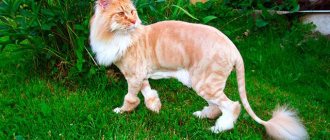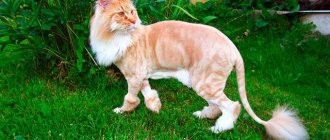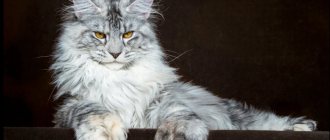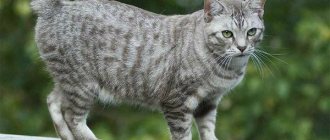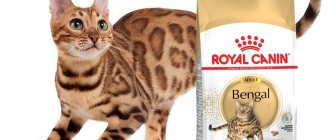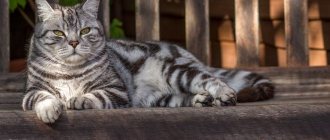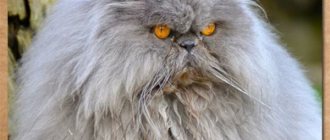The population of outbred cats has not been counted or classified in any way. They contain a fantastic cocktail of genes. And the “six handshakes” theory, widespread among people, is easily transferred to four-legged meowing “nobles” - family traits are easily recognized on their faces and in color.
And yet, street cats are a separate caste: with an individual character, health characteristics and maintenance rules.
History of the barn cat
The hypothesis of universal kinship is not an allegory at all. Geneticists conducted a study of 797 animals and found that they descend from at least 5 common ancestors on the maternal line. Among the test subjects were both purebred and barn cats. So a homely mongrel and a tribal aristocrat Persian are not so far from each other.
It has been scientifically proven that the founder of the genus was a wild steppe cat. It still lives in the space from the Far East to North Africa, confirming the powerful natural immunity and ability of the genus to survive. After this, is it any wonder why a yard cat adapts to any living conditions?
Archaeologists claim that next to humans, these animals appeared somewhere in the Fertile Crescent region (on the modern map, an arc from Turkey to Libya). At this time, people began to master agriculture, food supplies attracted rodents, and cats followed them. This is how the first wave of migration of these animals occurred and no one needs to be convinced that they were all outbreds.
After 2.5-3 thousand years, cats spread to North Africa and Europe. The active stage of domestication of these useful animals has begun. But until now, people have not completely tamed their wayward cats.
Strengths of mongrels
Each purebred cat is unique and valued for some of its exceptional characteristics. Yard mustaches may in some ways not be comparable to their purebred counterparts, but they have a lot of advantages:
- Health. The life expectancy of mongrels is usually longer than that of purebred purrs, because the former have a stronger and more lasting immunity to most street infections. Selection work weakens the protective functions of the cat’s body.
- Temperament. Domestic breeds have the most flexible and gentle character. If such a cat is picked up on the street, then its joy will know no bounds - it will become attached to its owner for life.
- Knitting. Finding a partner for a yard pet will not be difficult. Most likely you will have many options to choose from. Waiting for a new offspring is always a mystery, because it is impossible to predict what coat color, color and eye shape the future kittens will have. It is quite possible that such a kitten will become the founder of a new breed.
- Help with housekeeping. Catching an annoying rodent will not be difficult for a mongrel; they have a well-developed natural instinct.
- Exhibitions. There are exhibitions for outbred pets, where the external characteristics of purrs and their grooming are assessed. It’s great that yard breeds also have the opportunity to show themselves in all their glory.
- Price. Anyone can buy a yard pet. Usually they come to visit themselves, offering to leave themselves. In this case, it is almost impossible to refuse.
Is there a street breed?
The division based on appearance happened much later:
- The history of breeds begins in 1000. Around this time, the first mentions of the Norwegian forest cat date back to this time. She is also considered the ancestor of the Siberian longhaired population.
- Later, Siamese, Abyssinians, Egyptian Mau, Persians and Turkish Angora were identified. Even the names clearly show the region from which they all migrated to Europe.
- 1758 Swedish naturalist Carl Linnaeus introduced the concept of Felis catus, a binomial name for the species.
- 17 years later (1775), his colleague from Germany von Schreber supplemented this section with the name Felis silvestris, identifying wild cats as a separate group.
- 1871 The first official cat show took place in London - 170 animals were shown in 25 categories.
From that moment on, the cat world was divided into purebred purebreds and simple street cats.
No one would dare to claim that outbred cats have any characteristic features. The point is not only in their diversity, but also in their amazing adaptability. Even formerly pampered pets quickly adapt to the street.
They have offspring with any homeless partner and thereby replenish the population of outbred animals.
There is a street breed of cats: they are counted not on the basis of size, build and color, but on the basis of the “cat’s soul.” Some of them value freedom much more than close communication with people.
There are more of us and we are striped
Outbred cats make up 90% of the entire cat population of the planet. And no other breed can boast of such a variety of coat colors, body dimensions and characters as these felines have. The history of coexistence between humans and cats goes back almost 10 thousand years. In that distant time, cats were not divided into breeds. People were more interested in the practical benefits of pets. They have always been valued as excellent hunters of small rodent pests.
Outbred domestic cats are the best mouse hunters
At different times, attitudes towards cats were ambiguous. The ancient Egyptians deified these animals, and in medieval Europe they were credited with a connection with evil spirits. Domestic or yard cats, descended from wild ancestors, were common on all continents. Differences in climate and nutrition led to a variety of characters and appearance. Some modern breeds, in the formation of which man did not participate, can be considered yard (Siberian and Siamese cats, Angoras and Persians).
Different conditions - different appearance
The diversity of yard cats is explained by their non-standard genotype. It is impossible to guess, let alone calculate what kind of offspring an outbred cat will bring. The mixing of many breeds, and therefore hereditary characteristics, leads to the fact that yard kittens are born with a variety of coat colors and body sizes. Different eye colors, length and shape of tail and ears. The most common color of outbred murki is brindle or spotted. It allows you to camouflage in “field conditions”. A white barn cat is very rare. Individuals with long hair are also rare. Almost all representatives of the yard cat fraternity are short-haired. Medium size. Weight does not exceed 6 kilograms. Conventionally, mongrels are divided into two types according to the climatic conditions in which the breed was formed: northern and southern. The former have a dense, massive constitution and long, thick hair. Southerners are more graceful, with a thin skeleton and short hair without a pronounced undercoat.
The most common coloring of wild cats is stripes on a light background.
Angelic character of a wild beast
Where yard cats have a clear advantage over purebred cats is in their character traits and attitude towards their owners. By adopting a mongrel kitten, you can be sure that a creature has settled in the house who will be grateful to you all its life.
Outbred cats are restrained in showing emotions. It is as difficult to predict a pet's character as it is to predict its appearance. Some can be curious and restless. Others behave like born aristocrats, showing honor by the very fact of their existence.
Wild street cats are real predators
A kitten brought into the house, especially if it was born on the street, may be shy and wild at first. From birth, his mother cat taught him to be afraid of people. Only love and patience will help here. The animal will treat the person who will feed and care for the kitten as a kind deity. A mongrel pet treats all family members equally, but chooses its owner, distinguishing him from others.
A barn cat may not be very sociable. Self-sufficiency is one of the main traits of a cat’s character. Anger, aggressiveness and touchiness are extremely rare in a purebred cat. Like all cats, tabby mongrels love to play. Having become accustomed to the company of people and having become attached to them, it is difficult to endure long-term loneliness. Up to mental disorders. Try not to let this happen. In addition, cats can be very vindictive and vindictive. For lack of attention or offense they may damage furniture or use their favorite shoes as a toilet.
Appearance of outbred cats
Classification of outbred cats is carried out in standard ways: by weight and size, by coat length, by color.
By weight and size:
- large (over 7 kg);
- medium (4-7 kg);
- small (up to 4 kg).
Additionally, the height and length of a mongrel cat are considered. Sometimes the weight of the animal does not reach the required values due to its light bones, but its body is long and has high legs. Such cats are included in the first group. The same applies to small ones, when small height is compensated by significant weight.
Wool length:
- long-haired;
- semi-longhaired;
- shorthaired
The type of hair in cats is determined by a set of specific genes passed on to them from their parents: the L- allele is an attribute of short hair, and ll characterizes the preference for long and semi-long hair. Depending on the genetic pedigree of mongrel cats, long-haired parents may produce short-haired children.
In color, the genotype also comes first. It is impossible to guess the color of the offspring of outbred cats in advance, and no one sets such a task. The colors of street tramps offer a wide choice for every taste - from pure white to tiger mixed with tortoiseshell.
There are many of them and they are wearing vests
Cats that do not belong to any particular breed make up almost 90% of the world's purring population. Tamed by the ancient Egyptians, these animals faithfully serve man to this day.
Outbred cats are the most numerous representatives of their kind
Since the purr was loved not only in the Nile Valley, but throughout the globe, in different parts of the planet domuses (as domestic mongrel felinologists call them) began to look different over time.
Currently, experts classify simple fluffy cats living in apartments as either a street breed (a cross between several breeds, in the formation of which humans no longer participated) or a street-aboriginal breed (when yard cats descend from wild local purrs). The latter are divided into the following varieties:
- Celtic cats (European shorthair);
- Siamese cats;
- Angora cats;
- Persian cats;
- Siberian cats.
Initially, people were not involved in the selection of street fluffies, so among these purrs there are both blue-eyed and green-eyed beauties. The tails of mixed-breed cats can be either long or short, which is also true for the ears and the body as a whole.
The appearance of outbred cats is influenced by their habitat and climate. Thus, northern murkas are distinguished by their massive build and long hair with a thick undercoat. And on the southern shores, graceful and slender seals with short, easily blown fur are more common. And the weight of smooth-haired Domus is no more than 6 kg.
The length of the fur of outdoor cats depends on the climate
The specificity of origin also affects the process of pigmentation of the coat of a mongrel cat. Among the representatives of the species there are both spotted and monochromatic purrs. The palette of colors amazes the imagination with its diversity - here you can find red cats, black, gray, and even happy tri-colored ones.
Thus, despite the unflattering name, a simple street kitten may well grow into a beautiful and graceful animal with an unusual fur coat and bright eyes
The main thing is to show him due care and attention
How to distinguish a purebred cat from a mongrel animal
At first glance, the differences lie on the surface. If a cat has reddish short hair, a characteristic color-point color and bright blue eyes, then no one doubts that this is a purebred Siamese. But brown pupils, a sixth toe or an overly large mask instantly exclude this aristocrat from the purebred group.
Which animals fall under the definition of outbred:
- In the first place is the culling of breeding animals. It includes all individuals that are not suitable for breeding and exhibition. Such cats cannot be called outbred, but they are also not considered to be among the elite cohort.
- Next come the mixed breeds - the owners did not keep track of the walking cat, but she delighted them with mixed offspring. The appearance may be impeccable, a fake pedigree can deceive an expert, but as soon as it comes to kittens, everything immediately falls into place. Mestizos do not guarantee quality children.
- The final group is ordinary outbred cats, at first glance one can immediately identify 10 generations of street strays. They come in all sizes, coat types and colors.
The listed animals belong to the group of domus - good companions for their owners, but without certain characteristics of the breed or with its unconfirmed characteristics.
It happens that outbred cats and their elite brothers can only be recognized by expert felinologists. An example of such camouflage is the rare Arabian Mau breed. In its white and red color variants, it is simply impossible to distinguish it from an ordinary village cat.
“Not purebred” or non-standard genotype
The appearance of an unborn yard kitten is very difficult to predict, because it is born from a mixture of two or even several breeds. Therefore, color, coat length, eye color and other characteristics are always a pleasant surprise.
– varied. The variety of coat colors of mongrels can be the envy of any exotic purr participating in championships. This can be a single coat color or a combination of two or even several shades. The patterns and markings on the base color also vary. A common color is dark stripes on a light background. It is this pattern that helps the animal camouflage itself in natural conditions and hunt successfully.
The mongrels are in most cases medium in size, and their weight ranges from 3 to 6 kg.
The character of yard cats, unlike purebred cats, is varied. They are not characterized by aggression and touchiness. They generally show emotions very carefully.
These cats have a negative attitude towards the absence of their owners and can even fall into a kind of “cat” depression. This is manifested by refusal of food, hair loss, etc. But this condition mainly applies to “apartment” cats that cannot freely go outside.
Character and habits of outbred cats
The breeds share some common behavioral traits. But you won’t be able to predict the character of a mongrel cat by its appearance. Although, if his ear is torn and his tail is broken in three places, we are talking about a typical street bully.
The opinion about the obligatory gratitude of yard cats for shelter and food is also greatly exaggerated. The freedom-loving striped pet will graciously accept food, sometimes allow itself to be stroked and even purr on its owner’s lap. But freedom and the street are more important to him, and he does not recognize the authority of a person over himself. It’s not for nothing that they say that a cat walks on its own.
Another behavior scenario is a complete coincidence of the characters of a cat and a person. Here an idyllic picture emerges when the animal does not take its eyes off its adored owner, runs after him through the rooms and uses any excuse to climb onto his lap.
Thanks to this, yard cats have earned a reputation as grateful and sympathetic companions.
The habits of former street cats rarely change when they find a home. The excitement of the hunt does not subside, the desire for uncontrolled reproduction does not stop, and sooner or later their independence forces them to retire under the sofa. In addition, they do not immediately forget life from hand to mouth and are ready to overeat around the clock.
Everything changes if a purebred cat is spayed or neutered. The character becomes calmer, the level of loyalty to the person and the desire to communicate with him increases. Aggression is expressed extremely rarely - the biological rhythm adapts to new conditions.
Features of the learning ability of street cats
It has been noticed that outbred kittens show more abilities than their purebred relatives. This cannot be called a characteristic feature, but professional trainers confirm this opinion. It’s not for nothing that the first artists of the famous “Yuri Kuklachev’s Cat Theater” were Kutka and Stepka, found on the street.
Yard kittens are more susceptible to the conditions of home life. They often grow up to be very sociable cats with a soft, good-natured character and affection for family members.
How to train to a tray?
After a few explanations, the baby will master his new toilet.
When buying a toilet, it is recommended to focus on an adult cat, so that you do not have to choose a new litter tray when the kitten grows up. As a filler, it is recommended to use one that clumps. According to the description of the properties, the product reliably absorbs moisture and prevents unpleasant odors from spreading throughout the room. It is enough to show the kitten the tray 1-2 times, and he will immediately understand its purpose.
Is it worth taking home stray cats?
The world is not without kind people, and the ever-decreasing population of stray animals always needs human help. The number of outbred cats in homes is several times higher than the number of their well-bred counterparts.
Veterinary experts consider three motives for which people take outdoor cats into their homes:
- compassion and desire to reduce the number of suffering animals;
- You don’t have to pay for a street kitten;
- a variety of types of feline “mongrels”, among which there is always a type suitable for “adoption”.
It has been noted that representatives of the yard cat breed almost never end up on the street again. People take full responsibility for the life of a stray animal and treat it with the same care as they treat expensive elite breeds.
Most often we are talking about yard kittens - in adulthood, animals are much less likely to find a new home.
Choosing a purebred cat
The decision is best made after the consent of all family members. Attention is drawn to the following circumstances:
- Age. A young cat will more easily enter a new environment and adapt to it. She had not yet developed the habits of a wandering life, and her character had not hardened in the struggle for survival.
- Health. Ordinary street kittens traditionally have strong immunity and natural endurance. Unlike purebred cats that undergo inbreeding, they rarely have genetic mutations. A healthy kitten should be playful, easy to run and jump, with shiny, even fur, pink gums and clean mucous membranes.
Appearance also plays a role in the selection process. They look at her first of all - after all, the aesthetic desire to own a beautiful animal overshadows everything.
The task is greatly simplified when it comes to the children of a domestic mongrel cat. Here the parents are already known (at least one of them), the kitten is under supervision and warm, and the mother cat has adequate feeding and the opportunity to raise her offspring.
No matter how healthy and active a mongrel kitten may seem, it must be shown to a veterinarian. Neglected childhood illnesses can turn into big problems.
Not purebred or non-standard genotype
Having looked at the photographs of yard cats, we can unequivocally say that many of them are very similar to purebred individuals. Such non-standard genotype is one of their key features.
Yard cats can come in a wide variety of colors.
It is impossible to predict in advance the appearance of an unborn kitten, since it is often a mixture of many breeds. Thanks to this variety of hereditary characteristics, animals can have a lot of colors, different sizes, eye colors and coat lengths. The only thing that a yard cat definitely cannot have is a complete lack of fur.
Street cats can boast a huge number of coat colors: no other known breed in the world has such diversity. It is believed that northern cats are massive and have fluffy fur, while representatives of the southern side are graceful, have fine hair and a small undercoat. This difference is due to the influence of climate and area of residence.
Among yard cats, there are often individuals with spotted colors, all kinds of patterns and markings. You can also find animals that have three colors (people call them lucky). But the most common color is considered to be a light base background with dark stripes on it. This coloring helps the cat to camouflage itself in nature and hunt effectively. White cats are very rare among mongrels.
Contrary to popular belief, it cannot be argued that purebred cats are superior to yard cats in terms of external characteristics and type of behavior. In addition, the powerful fusion of breeds from natural selection creates truly unique kittens. In the future, they grow into strong, handsome men with magnificent colors and a strong physique, which will be the envy of even the most “pure” breeds.
The character of yard cats is also ambiguous
Some of them are distinguished by absolute calm and meekness, others call themselves royalty with its inherent importance. Often, such animals are not characterized by touchiness and aggressiveness; they show their emotions quite carefully
Features of caring for outbred cats
There are no differences in the responsibilities for keeping outbred and purebred cats. Both the first and second require equal attention:
- The fur is combed out, especially in long-haired animals. A beautiful fur coat is considered a universal indicator of health and psychological state. If it loses its shine and the hairs do not lie flat, then the animal has problems.
- The mucous membranes of the eyes and nose must be kept clean. To do this, they are periodically processed and unsightly crusts are removed.
- The ears are carefully cleaned with a cotton swab or swab.
- If necessary, trim the claws.
- The teeth of the descendants of feline mongrels usually remain healthy for a long time, but from time to time they also need to look into their mouths.
The only relaxation in maintenance and care is the absence of the need to select an appropriate gentleman for a mongrel cat. Here the choice is so great that no one has any difficulties.
Eye colors
Cat with green eyes
The most common cat eye color is green. This color goes well with any color, including gray striped. Very bright, emerald or grassy, rare. Much more often the eyes have an olive or gooseberry tint.
Almost as often, cats have yellow eye shades - light lemon and yellow-green.
Orange iris colors look very impressive and are usually found in ginger cats. Shades range from copper to amber-walnut.
In a white cat with green or yellow eyes, the coat color is controlled by the piebald gene.
The rarest of colors is blue, from light to rich. Typically, white cats have blue eyes, unfortunately, which are associated with various diseases that are associated with the white gene.
An extremely rare case is heterochrony - different colors of the iris. That is, when a cat has one eye, for example, blue, and the other orange. For cat lovers, this combination is considered the most desirable.
Feeding mongrel cats
Feeding a mongrel street dweller can be a bit of a hassle. There are fewer problems with babies, but if a cat has managed to live in freedom and is accustomed to picking up food from the ground, it is almost impossible to re-educate it.
- At an early age, babies are given diluted goat's milk or special infant formula. Outbred kittens separated from their mother prematurely have not yet learned to eat and will require additional attention.
- For adolescents, the diet is increased by boiled minced meat in a liquid consistency or age-appropriate industrial food.
- Closer to six months, meat, fish, dairy products, vegetables and fruits are introduced into the cat’s menu.
- It is necessary to provide feed yeast and vitamin and mineral supplements. No matter how strong the natural immunity of a purebred cat may be, its support is mandatory.
- There must be water next to the food. The animal's access to it is left free around the clock.
Find out also: “What to feed kittens of different ages.”
Choosing cookware is not a difficult task. Plastic bowls are convenient and inexpensive, but their porous structure traps microscopic food debris. Therefore, it is necessary to thoroughly wash surfaces to prevent the growth of bacteria.
Those with large mustaches are the most picky about dishes. If they cling to the sides of the bowl, the cat begins to experience discomfort.
How much money does a kitten cost, should I pay or not?
When the issue with the appearance and desired character of the pet has been resolved, all that remains is to determine how much money you are willing to spend on purchasing the animal. Of course, if you plan to purchase a “status” kitten, or a show kitten with a good pedigree, you will have to pay an nth amount and, often, this amount is quite a “tidy” amount. Pedigree or non-pedigreed cats are better for home - it depends on your wallet.
If you do not expect to make a large financial investment for a small animal, then you should turn to numerous message boards about placing animals in responsible hands. In the Internet era, searches are simplified by the fact that advertisements are posted on the Internet with already attached photographs of “applicants for good hands.”
You can also ask your friends - perhaps one of them has a domestic cat that recently gave birth. And another option is to pick up a homeless person on the street. But it is more likely for brave altruists who are ready to take a risk and take into their home an animal without a clan or tribe. And this risk will be that there is a possibility of picking up a kitten with a whole bunch of infections. And the treatment in this case will fall entirely on the shoulders of the new owner.
In addition, it is almost impossible to find out what the parents of such a child were like if they did not all live on the street together. If you take a kitten through an advertisement or from friends, then you can find out a lot of useful information from the owners of the cat’s mother about her character, valuable qualities and any diseases, if any.
If you do not want to buy a “pig in a poke,” then the mixed-breed option is not for you. Choose a breed. It is best to buy purebred animals not at a bird farm or even at a pet store, but from trusted breeders or, again, from friends whom you personally know well.
The standard characteristics of a purebred cat (character, size, color, etc.) can be found out in advance from relevant sources, or from the breeder himself. After all, most breeds were bred through artificial selection, therefore each breed differs from any other precisely by those qualities that have been maintained in it from generation to generation by breed specialists.
When choosing a purebred animal, you can know in advance how it will grow with a high percentage of accuracy.
If we take a closer look at the difference between purebred and outbred cats, we can highlight some of their main advantages and disadvantages.
Pros and cons of outbred cats
Advantages and disadvantages of purchasing an ordinary, outbred kitten.
| pros | Minuses |
| Low cost or free | It is impossible to make money from breeding and selling kittens |
| Good immunity and health | Not allowed to participate in exhibitions |
| Possibility to choose appearance | |
| No problems in content | |
| No special feeding requirements |
Inviting a purebred cat into your home is a noble act that will be impossible to beat in the future. Because true nobility can only be with a plus sign!
Domestic cat health
Ordinary yard cats have long been valued by pet lovers for their good health and the absence of genetic diseases, which purebred purrs often cannot boast of. This feature was formed over centuries in the wild and remained with cats even after they settled under the same roof with humans.
Domestic cats are renowned for their good health
Good immunity becomes the basis for a long and interesting life for outbred cats. After all, these animals reach old age at 8–9 years, and the average life expectancy is 10–12 years. Often there are also long-livers, “reaching out” to 16–17 years of age.
However, when it comes to the health of domuses, you need to take into account some features:
- if among the pet’s ancestors there were purebred individuals, then you should be prepared for the manifestation of hereditary ailments;
- Tolerability of drugs is strictly individual and it is very difficult to predict the consequences of anesthesia or the effects of other medications.
Outbred cats are not protected from typical “street” diseases - ringworm, helminths and fleas. Therefore, after a yard kitten gets into your home, you definitely need to go with your baby to the veterinarian and save the fluffy from such misfortunes.
And to ensure your beloved mustache has a long and happy life, it is important to get vaccinated regularly. Moreover, after one year of age, vaccinations need to be done only once a year.

